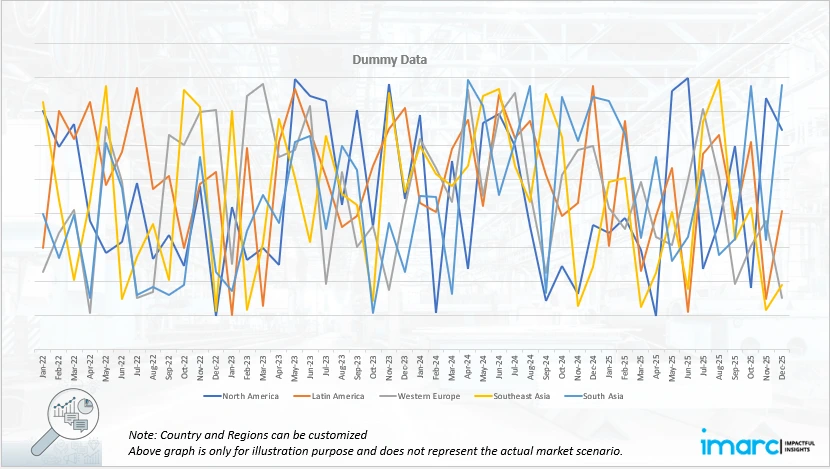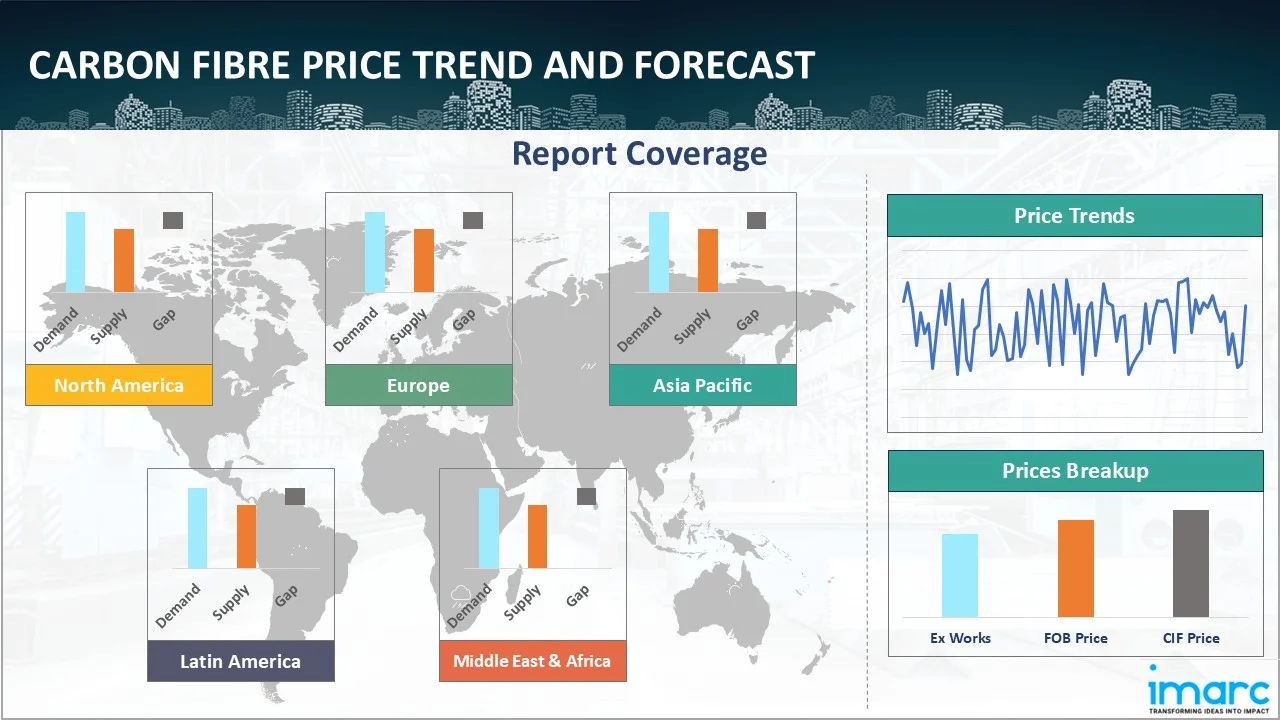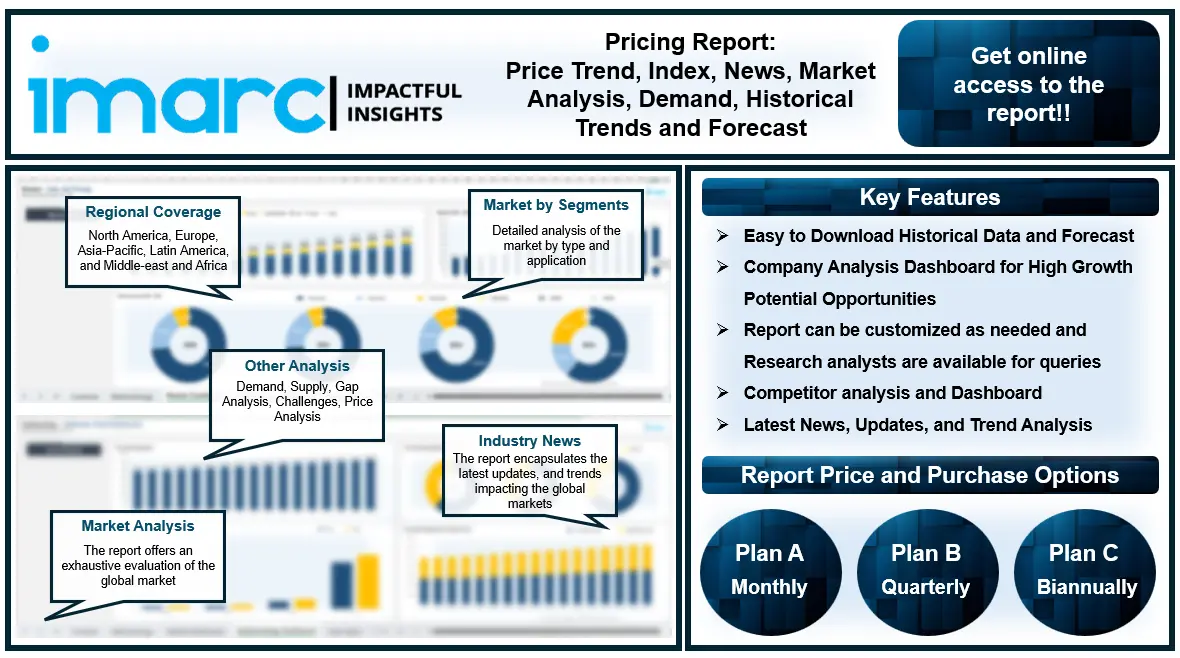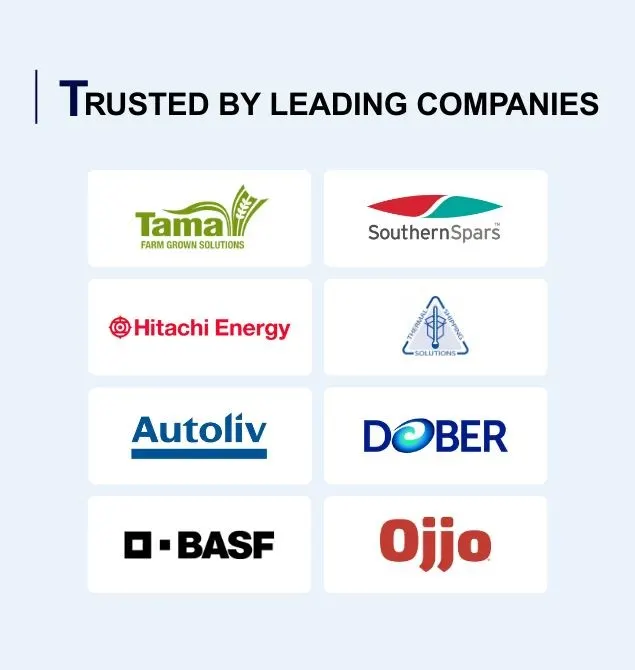
Carbon Fibre Prices, Trend, Chart, Demand, Market Analysis, News, Historical and Forecast Data Report 2025 Edition
Carbon Fibre Price Trend, Index and Forecast
Track the latest insights on carbon fibre price trend and forecast with detailed analysis of regional fluctuations and market dynamics across North America, Latin America, Central Europe, Western Europe, Eastern Europe, Middle East, North Africa, West Africa, Central and Southern Africa, Central Asia, Southeast Asia, South Asia, East Asia, and Oceania.
Carbon Fibre Prices Outlook Q3 2025
- Germany: USD 32.8/KG
- United Kingdom: USD 34.2/KG
- Thailand: USD 30.8/KG
- South Korea: USD 37.3/KG
- Argentina: USD 28.2/KG
Carbon Fibre Price Chart

Get real-time access to monthly/quarterly/yearly prices Request Sample
During the third quarter of 2025, the carbon fibre prices in Germany reached 32.8 USD/KG in September. Market conditions were shaped by shifts in procurement from aerospace and automotive manufacturers, which remained key consumers of advanced composite materials. Production costs were influenced by the energy-intensive nature of precursor and oxidation processes, especially as energy markets remained sensitive to regional industrial activity.
During the third quarter of 2025, the carbon fibre prices in the United Kingdom reached 34.2 USD/KG in September. Demand growth from defense, wind energy, and premium automotive applications supported overall pricing. Supply conditions reflected continued reliance on upstream PAN based precursor imports, with logistics and maritime freight contributing to procurement costs. Regulatory certification for structural composites added procedural expenses for producers and distributors.
During the third quarter of 2025, the carbon fibre prices in Thailand reached 30.8 USD/KG in September. Market sentiment was shaped by moderate demand from sporting goods, industrial components, and emerging electric vehicle supply chains. Production activities were affected by the cost of imported precursor materials and intermediates, as Thailand remained dependent on external suppliers for key carbonization inputs. Port handling charges and container availability played a role in determining final market prices.
During the third quarter of 2025, the carbon fibre prices in South Korea reached 37.3 USD/KG in September. Strong demand from electronics, automotive composites, and plant equipment sectors influenced procurement volumes. Supply fundamentals were supported by established domestic production capabilities, though precursor processing and heat treatment stages contributed significantly to overall costs. Export focused manufacturers navigated certification and quality assurance requirements, adding to processing expenses.
During the third quarter of 2025, the carbon fibre prices in Argentina reached 28.2 USD/KG in September. Demand trends were shaped by activities in industrial fabrication, automotive parts, and infrastructure reinforcement applications. Supply conditions were influenced by a high dependence on imported precursor materials. Import logistics, including customs procedures and port handling, represented a significant cost component. Domestic distribution costs were further impacted by internal transport constraints.
Carbon Fibre Prices Outlook Q2 2025
- Germany: USD 33.2/KG
- United Kingdom: USD 33.5/KG
- Thailand: USD 31.3/KG
- South Korea: USD 36.8/KG
- Argentina: USD 27.8/KG
During the second quarter of 2025, carbon fibre prices in Germany reached 33.2 USD/Kg in June. Carbon fibre prices in Germany remained broadly stable, supported by steady demand from the automotive, aerospace, and renewable energy sectors. German manufacturers maintained sufficient supply levels to meet industrial requirements, despite fluctuations in the costs of precursor materials. The push for lightweight materials in electric vehicle production and wind turbine components continued to sustain market activity.
During the second quarter of 2025, carbon fibre prices in the United Kingdom reached 33.5 USD/Kg in June. In the United Kingdom, carbon fibre prices held steady, supported by demand from aerospace, automotive, and construction sectors. Although post-Brexit import logistics presented minor challenges, domestic production and European imports stabilized supply. The renewable energy sector, particularly wind turbine production, contributed to consistent market activity. Energy cost variations had a slight impact on production expenses, but overall pricing trends remained balanced throughout the quarter.
During the second quarter of 2025, carbon fibre prices in Thailand reached 31.3 USD/Kg in June. In Thailand, carbon fibre prices remained stable during the second quarter of 2025, driven by consistent demand from the automotive, construction, and electronics industries. The government's push for advanced materials in infrastructure projects supported usage, while local supply chains maintained adequate stock levels. Import costs exhibited minor fluctuations due to currency fluctuations, but no significant price fluctuations occurred. The market reflected steady industrial consumption and stable supplier relationships during the quarter.
During the second quarter of 2025, carbon fibre prices in South Korea reached 36.8 USD/Kg in June. Carbon fibre prices in the region remained relatively steady, with consistent demand from the automotive and electronics sectors. The country's role as a key manufacturing hub ensured a stable supply, while the EV and wind energy sectors contributed to ongoing consumption. Although raw material costs fluctuated, domestic producers managed inventories efficiently, maintaining price stability. No major supply chain disruptions were reported, maintaining a balanced market sentiment throughout the quarter.
During the second quarter of 2025, carbon fibre prices in Argentina reached 27.8 USD/Kg in June. Carbon fibre prices in Argentina experienced mild volatility due to currency fluctuations and import dependency. However, demand from niche sectors such as sports equipment and lightweight industrial components kept the market active. Supply was sufficient to meet local requirements, although procurement costs remained sensitive to global market movements and logistical expenses. Overall, prices hovered within a stable range with localized adjustments.
Carbon Fibre Prices Outlook Q1 2025
- Germany: USD 34.5/KG
- United Kingdom: USD 34/KG
- Thailand: USD 33/KG
- South Korea: USD 38/KG
- Argentina: USD 27/KG
During the first quarter of 2025, the carbon fibre prices in Germany reached 34.5 USD/KG in March. As per the carbon fibre price chart, increased use of carbon fiber in wind energy caused a major impact on prices. Besides, key industries, including automotive, aerospace, and renewable energy, maintained demand for carbon fibre, influencing price changes.
During the first quarter of 2025, the carbon fibre prices in the United Kingdom reached 34 USD/KG in March. One of the key trends causing price fluctuations was the increasing adoption of carbon fibre for producing lightweight vehicles that are fuel-efficient. Besides, the UK's focus on sustainable transportation and renewable energy projects, such as wind turbines, also contributed to demand and prices.
During the first quarter of 2025, the carbon fibre prices in Thailand reached 33 USD/KG in March. The market experienced fluctuations with applications in the aerospace, automotive, and construction sectors. Besides, the heightened demand for lightweight materials in various end markets, including automotive and renewable energy sectors, further influenced prices.
During the first quarter of 2025, the carbon fibre prices in South Korea reached 38 USD/KG in March. Despite global challenges, including fluctuations in raw material costs and supply chain disruptions, the market demonstrated fluctuations. The country's established manufacturing infrastructure and strategic focus on high-performance materials further influenced trends.
During the first quarter of 2025, the carbon fibre prices in Argentina reached 27 USD/KG in March. The automotive sector in Argentina showed a growing interest in lightweight materials to enhance fuel efficiency and meet environmental regulations, contributing to demand and price fluctuations for carbon fibre.

Regional Coverage
The report provides a detailed analysis of the market across different regions, each with unique pricing dynamics influenced by localized market conditions, supply chain intricacies, and geopolitical factors. This includes price trends, price forecast and supply and demand trends for each region, along with spot prices by major ports. The report also provides coverage of FOB and CIF prices, as well as the key factors influencing carbon fibre prices.
Europe Carbon Fibre Price Trend
Q3 2025:
During the third quarter of 2025, the carbon fibre price index in Europe was shaped by fluctuating procurement volumes across aerospace, wind energy, and high strength composite applications. Regional supply chains navigated energy-linked production costs associated with precursor oxidation and high temperature carbonization. Imports of intermediate materials reflected logistical handling charges across major ports. Certification requirements for structural composites added processing obligations for manufacturers.
Q2 2025:
In Europe, carbon fibre prices exhibited minimal fluctuations, with the market primarily driven by steady demand from the aerospace, renewable energy, and automotive sectors. An increased focus on sustainability and lightweight components helped maintain stable consumption, while domestic production remained aligned with market needs. Overall, Europe maintained a balanced market environment, with carbon fibre prices reflecting consistent industry activity throughout the quarter.
Q1 2025:
As per the carbon fibre price index, rising energy prices and stricter environmental regulations in Europe contributed to higher manufacturing expenses, impacting carbon fibre pricing. Besides, the aerospace sector maintained demand for carbon fibre, supporting prices. Moreover, ongoing global supply chain adjustments further caused volatility in the market.
This analysis can be extended to include detailed carbon fibre price information for a comprehensive list of countries.
| Region | Countries Covered |
|---|---|
| Europe | Germany, France, United Kingdom, Italy, Spain, Russia, Turkey, Netherlands, Poland, Sweden, Belgium, Austria, Ireland, Switzerland, Norway, Denmark, Romania, Finland, Czech Republic, Portugal, and Greece, among other European countries. |
North America Carbon Fibre Price Trend
Q3 2025:
During the third quarter of 2025, the carbon fibre price index in North America reflected steady consumption from defense, aerospace, and advanced engineering sectors. Production fundamentals were influenced by energy intensive precursor conversion stages. Import shipments faced cost additions related to ocean freight and port handling. Domestic logistics and regulatory compliance also contributed to operational expenses. Regional demand for high performance composite components supported underlying pricing structures.
Q2 2025:
In North America, carbon fibre prices exhibited a stable trend throughout Q2 2025, supported by consistent demand from the aerospace, automotive, and construction industries. While raw material inputs experienced mild cost fluctuations, suppliers were able to maintain balanced inventories, thereby minimizing any significant price shifts. The growing focus on lightweight materials in transportation and defense applications maintained steady purchasing activity. Overall, the regional market reflected a stable pricing environment, with no significant disruptions in supply or demand dynamics during the quarter.
Q1 2025:
Prices were influenced by easing energy costs and steady demand from the automotive and industrial sectors. Besides, increasing product adoption in emerging applications, such as hydrogen storage and urban air mobility, further caused volatility. Moreover, sector-specific demand and evolving production costs also played a major role in shaping pricing trends.
Specific data on carbon fibre prices within the United States and Canada can also be provided.
| Region | Countries Covered |
|---|---|
| North America | United States and Canada |
Middle East and Africa Carbon Fibre Price Trend
Q3 2025:
As per the carbon fibre price chart, the prices in the Middle East and Africa fluctuated due to a complex interplay of factors, primarily driven by supply chain disruptions, seasonal demand shifts, and geopolitical influences.
Q2 2025:
The report explores the carbon fibre trends and carbon fibre price chart in the Middle East and Africa, considering factors like regional industrial growth, the availability of natural resources, and geopolitical tensions that uniquely influence market prices.
In addition to region-wise data, information on carbon fibre prices for countries can also be provided.
| Region | Countries Covered |
|---|---|
| Middle East & Africa | Saudi Arabia, UAE, Israel, Iran, South Africa, Nigeria, Oman, Kuwait, Qatar, Iraq, Egypt, Algeria, and Morocco, among other Middle Eastern and African countries. |
Asia Pacific Carbon Fibre Price Trend
Q3 2025:
During the third quarter of 2025, carbon fibre prices in the Asia Pacific region were driven by consumption in electronics manufacturing, automotive lightweighting, and industrial components. Production activities in major manufacturing hubs were shaped by energy based operational costs. Import logistics and regional shipping movements added cost considerations. Compliance with quality specifications for export oriented products influenced processing expenses. Domestic distribution and handling contributed further to final pricing.
Q2 2025:
In the Asia Pacific region, carbon fibre prices remained largely stable during the second quarter of 2025, despite minor cost adjustments in precursor materials such as PAN. Strong demand from the automotive and sporting goods sectors, especially in China and Japan, kept the market active. However, regional producers maintained an adequate supply, offsetting any potential price pressure. Export activity also remained consistent, contributing to a balanced pricing landscape. The overall market in Asia Pacific reflected steady consumption patterns and stable production capacity.
Q1 2025:
The automotive and aerospace sectors saw a rise in the adoption of carbon fiber for lightweight, high-performance applications. Besides, rapid industrialization, technological advancements, and increasing focus on energy efficiency, especially in developing countries, further caused price changes. Moreover, the automotive and aerospace sectors saw a rise in the adoption of carbon fiber for lightweight, high-performance applications, influencing prices.
This analysis can be further extended to include detailed carbon fibre prices for a comprehensive list of countries within the region.
| Region | Countries Covered |
|---|---|
| Asia Pacific | China, India, Indonesia, Pakistan, Bangladesh, Japan, Philippines, Vietnam, Thailand, South Korea, Malaysia, Nepal, Taiwan, Sri Lanka, Hongkong, Singapore, Australia, and New Zealand, among other Asian countries. |
Latin America Carbon Fibre Price Trend
Q3 2025:
During the third quarter of 2025, carbon fibre prices in Latin America were supported by industrial and automotive sector consumption. Supply conditions were affected by import reliance for precursor materials. Port logistics, customs procedures, and inland freight formed a substantial portion of cost components. Market participants accounted for compliance obligations and distribution routes, shaping regional pricing outcomes.
Q2 2025:
In Latin America, carbon fibre prices remained relatively steady, with limited fluctuations observed across major regional markets. The aerospace, automotive, and wind energy sectors experienced moderate demand, which supported stable pricing. However, supply chain normalization following the disruptions of previous quarters eased pressure on procurement, contributing to consistent availability. Although raw material costs such as PAN (polyacrylonitrile) showed slight variations, manufacturers maintained balanced production levels. Overall, the carbon fibre market in Latin America reflected a stable price environment.
Q1 2025:
As per the carbon fibre price index, prices in Latin America were influenced by a combination of factors, including global supply and demand, trade policies, and the region's specific economic conditions. Besides, trade policies between the US and Latin American countries, particularly Mexico, further affected pricing.
This comprehensive review can be extended to include specific countries within the region.
| Region | Countries Covered |
|---|---|
| Latin America | Brazil, Mexico, Argentina, Columbia, Chile, Ecuador, and Peru, among other Latin American countries |
Carbon Fibre Pricing Report, Market Analysis, and News
IMARC's latest publication, “Carbon Fibre Prices, Trend, Chart, Demand, Market Analysis, News, Historical and Forecast Data Report 2025 Edition,” presents a detailed examination of the carbon fibre market, providing insights into both global and regional trends that are shaping prices. This report delves into the spot price of carbon fibre at major ports and analyzes the composition of prices, including FOB and CIF terms. It also presents detailed carbon fibre prices trend analysis by region, covering North America, Europe, Asia Pacific, Latin America, and Middle East and Africa. The factors affecting carbon fibre pricing, such as the dynamics of supply and demand, geopolitical influences, and sector-specific developments, are thoroughly explored. This comprehensive report helps stakeholders stay informed with the latest market news, regulatory updates, and technological progress, facilitating informed strategic decision-making and forecasting.

Carbon Fibre Industry Analysis
The global carbon fibre market size reached USD 245.17 Million in 2025. By 2034, IMARC Group expects the market to reach USD 480.43 Million, at a projected CAGR of 7.76% during 2026-2034. The market is primarily driven by the increasing adoption in aerospace, automotive lightweighting, renewable energy components, and high strength industrial applications, expanding use of advanced composites across engineering sectors, and rising focus on energy efficient materials.
Latest developments in the carbon fibre industry:
- October 2025: Toray Industries reported the creation of a new recycling technology that can break down various types of carbon fibre reinforced plastics (CFRP) made with thermosetting resins while preserving the recovered fibres’ strength and surface integrity. Using this innovation, the company also produced a non-woven fabric manufactured from reclaimed carbon fibres.
Product Description
Carbon fibre, renowned for its lightweight and high-strength characteristics, is primarily manufactured of carbon atoms. When these atoms are naturally bonded using crystallographic arrangement, they tend to form a fibre that is stiff, strong, and highly resistant in terms of flexibility. Due to its uniqueness in having a very high stiffness-to-weight ratio, this material is ideal candidate for use in all high-performance applications where there need not be any significant weight such as aerospace, automotive, and sports equipment manufacturing platforms. This material sometimes stays together with other elements within the sub-micron level.
The production journey involves polymerizing acrylonitrile, followed by stages of oxidation and carbonization, culminating in the unique filamentous structure of carbon fibre. Given its advanced attributes, carbon fibre is increasingly embraced in pioneering technology and engineering projects, signifying a substantial leap in material science advancements.
Report Coverage
| Key Attributes | Details |
|---|---|
| Product Name | Carbon Fibre |
| Report Features | Exploration of Historical Trends and Market Outlook, Industry Demand, Industry Supply, Gap Analysis, Challenges, Carbon Fibre Price Analysis, and Segment-Wise Assessment. |
| Currency/Units | US$ (Data can also be provided in local currency) or Metric Tons |
| Region/Countries Covered | The current coverage includes analysis at the global and regional levels only. Based on your requirements, we can also customize the report and provide specific information for the following countries: Asia Pacific: China, India, Indonesia, Pakistan, Bangladesh, Japan, Philippines, Vietnam, Thailand, South Korea, Malaysia, Nepal, Taiwan, Sri Lanka, Hongkong, Singapore, Australia, and New Zealand* Europe: Germany, France, United Kingdom, Italy, Spain, Russia, Turkey, Netherlands, Poland, Sweden, Belgium, Austria, Ireland, Switzerland, Norway, Denmark, Romania, Finland, Czech Republic, Portugal and Greece* North America: United States and Canada Latin America: Brazil, Mexico, Argentina, Columbia, Chile, Ecuador, and Peru* Middle East & Africa: Saudi Arabia, UAE, Israel, Iran, South Africa, Nigeria, Oman, Kuwait, Qatar, Iraq, Egypt, Algeria, and Morocco* *The list of countries presented is not exhaustive. Information on additional countries can be provided if required by the client. |
| Information Covered for Key Suppliers |
|
| Customization Scope | The report can be customized as per the requirements of the customer |
| Report Price and Purchase Option |
Plan A: Monthly Updates - Annual Subscription
Plan B: Quarterly Updates - Annual Subscription
Plan C: Biannually Updates - Annual Subscription
|
| Post-Sale Analyst Support | 360-degree analyst support after report delivery |
| Delivery Format | PDF and Excel through email (We can also provide the editable version of the report in PPT/Word format on special request) |
Key Benefits for Stakeholders:
- IMARC’s report presents a detailed analysis of carbon fibre pricing, covering global and regional trends, spot prices at key ports, and a breakdown of FOB and CIF prices.
- The study examines factors affecting carbon fibre price trend, including input costs, supply-demand shifts, and geopolitical impacts, offering insights for informed decision-making.
- The competitive landscape review equips stakeholders with crucial insights into the latest market news, regulatory changes, and technological advancements, ensuring a well-rounded, strategic overview for forecasting and planning.
- IMARC offers various subscription options, including monthly, quarterly, and biannual updates, allowing clients to stay informed with the latest market trends, ongoing developments, and comprehensive market insights. The carbon fibre price charts ensure our clients remain at the forefront of the industry.
Need more help?
- Speak to our experienced analysts for insights on the current market scenarios.
- Include additional segments and countries to customize the report as per your requirement.
- Gain an unparalleled competitive advantage in your domain by understanding how to utilize the report and positively impacting your operations and revenue.
- For further assistance, please connect with our analysts.
Why Choose Us
IMARC offers trustworthy, data-centric insights into commodity pricing and evolving market trends, enabling businesses to make well-informed decisions in areas such as procurement, strategic planning, and investments. With in-depth knowledge spanning more than 1000 commodities and a vast global presence in over 150 countries, we provide tailored, actionable intelligence designed to meet the specific needs of diverse industries and markets.
1000
+Commodities
150
+Countries Covered
3000
+Clients
20
+Industry
Robust Methodologies & Extensive Resources
IMARC delivers precise commodity pricing insights using proven methodologies and a wealth of data to support strategic decision-making.
Subscription-Based Databases
Our extensive databases provide detailed commodity pricing, import-export trade statistics, and shipment-level tracking for comprehensive market analysis.
Primary Research-Driven Insights
Through direct supplier surveys and expert interviews, we gather real-time market data to enhance pricing accuracy and trend forecasting.
Extensive Secondary Research
We analyze industry reports, trade publications, and market studies to offer tailored intelligence and actionable commodity market insights.
Trusted by 3000+ industry leaders worldwide to drive data-backed decisions. From global manufacturers to government agencies, our clients rely on us for accurate pricing, deep market intelligence, and forward-looking insights.
 Request Customization
Request Customization
 Inquire Before Buying
Inquire Before Buying
 Speak to an Analyst
Speak to an Analyst Request Brochure
Request Brochure




.webp)




.webp)












